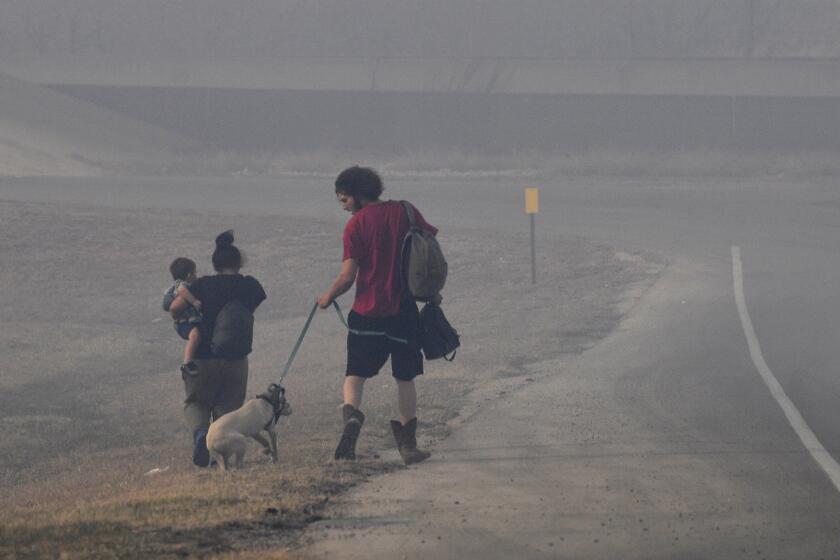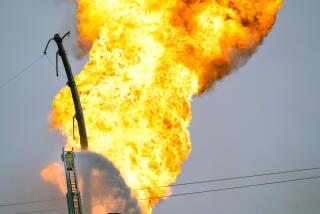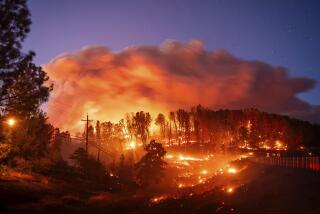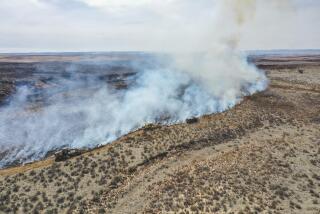Wildfire scorching the Texas Panhandle has grown to the largest in state history
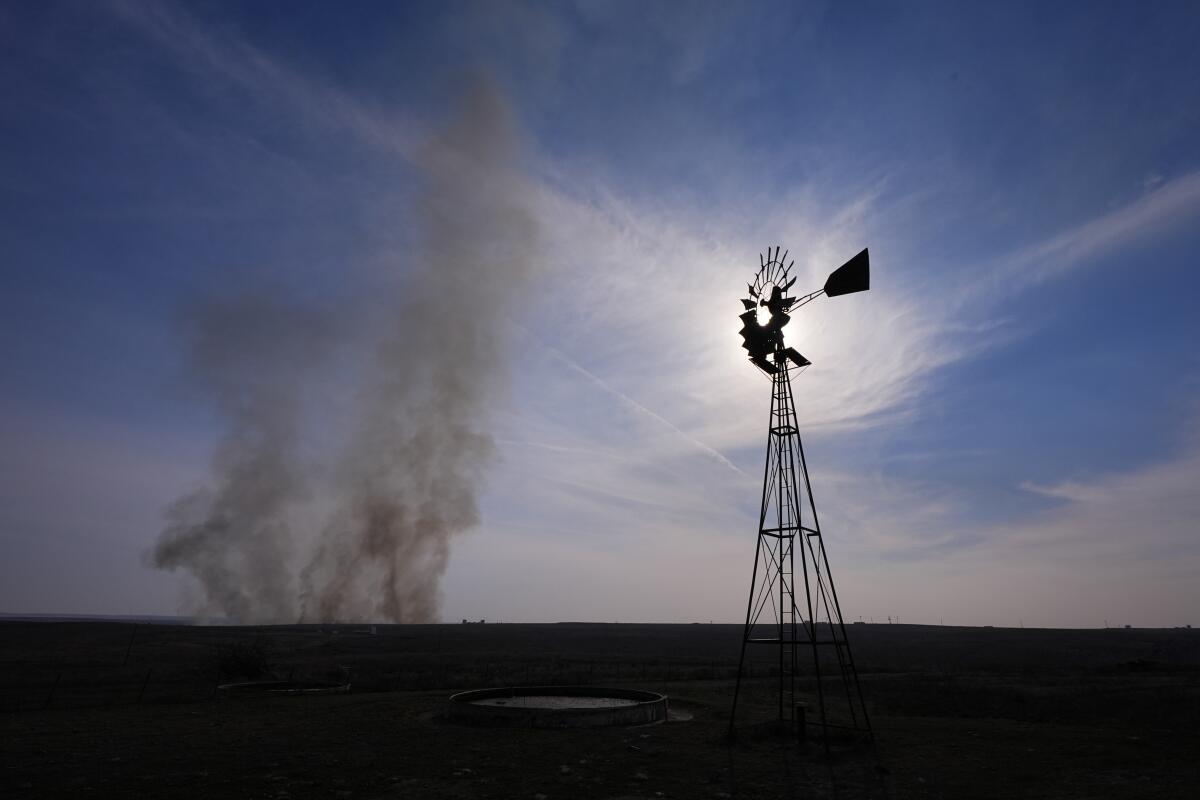
- Share via
STINNETT, Texas — A dusting of snow covered a desolate landscape of scorched prairie, dead cattle and burned-out homes in the Texas Panhandle on Thursday, giving firefighters brief relief in their desperate efforts to corral a blaze that has grown into the largest in state history.
The Smokehouse Creek fire grew to nearly 1,700 square miles. It merged with another fire and is just 3% contained, according to the Texas A&M Forest Service.
Gray skies loomed over huge scars of blackened earth in a rural area dotted with scrub brush, ranchland, rocky canyons and oil rigs. In Stinnett, a town of about 1,600, someone propped up an American flag outside a destroyed home.
Dylan Phillips, 24, said he hardly recognized his Stinnett neighborhood, which was littered with melted street signs and the charred frames of cars and trucks. His family’s home survived, but at least half a dozen others were smoking rubble.
A fast-moving wildfire burning through the Texas Panhandle has grown into the second-largest blaze in the state’s history.
“It was brutal,” Phillips said. “The streetlights were out. It was nothing but embers and flames.”
The Smokehouse Creek fire’s explosive growth slowed Thursday as snow fell, winds ebbed and temperatures dipped, but it was still untamed and threatening. It is the largest of several major fires burning in the rural Panhandle section of the state. It has also crossed into Oklahoma.
Firefighter Lee Jones was helping douse the smoldering wreckage of homes in Stinnett to keep them from reigniting when temperatures and winds increase Friday and into the weekend.
“The snow helps,” said Jones, who was among a dozen firefighters called in from Lubbock to help. “We’re just hitting all the hot spots around town, the houses that have already burned.”
Authorities have not said what ignited the fires, but strong winds, dry grass and unseasonably warm temperatures fed the blazes.
Texas fire crews hope to make progress Saturday against a massive complex of wildfires that have killed one person and burned at least 50 homes.
“The rain and the snow is beneficial right now; we’re using it to our advantage,” Texas A&M Forest Service spokesman Juan Rodriguez said of the Smokehouse Creek fire. “When the fire isn’t blowing up and moving very fast, firefighters are able to actually catch up and get to those parts of the fire.”
Authorities said 1,640 square miles of the fire were on the Texas side of the border. Previously, the largest fire in recorded state history was the East Amarillo Complex fire in 2006, which burned about 1,400 square miles and resulted in 13 deaths.
An 83-year-old woman was the only confirmed death so far this week. But with flames still menacing a wide area, authorities had yet to conduct a thorough search for victims or tally the numerous homes and other structures damaged or destroyed.
Gov. Greg Abbott has issued a disaster declaration for 60 counties and planned to visit the Panhandle on Friday.
Nim Kidd, chief of the Texas Division of Emergency Management, said the weekend forecast and “sheer size and scope” of the blaze are the biggest challenges for firefighters.
This article was originally on a blog post platform and may be missing photos, graphics or links.
“I don’t want the community there to feel a false sense of security that all these fires will not grow anymore,” Kidd said. “This is still a very dynamic situation.”
Jeremiah Kaslon, 39, a Stinnett resident who saw neighbors’ homes destroyed by flames that stopped just on the edge of his property, seemed prepared for what the changing forecast might bring.
“Around here, the weather, we get all four seasons in a week,” Kalson said. “It can be hot, hot and windy, and it will be snowing the next day. It’s just that time of year.”
The woman who died was identified by family members as Joyce Blankenship, a former substitute teacher. Her grandson, Lee Quesada, said he had posted in a community forum asking if anyone could try to locate her. Quesada said deputies told his uncle Wednesday that they had found Blankenship’s remains in her burned home.
Encroaching flames caused the main facility that disassembles America’s nuclear arsenal to pause operations Tuesday night, but it was open for normal work by Wednesday.
At least 156 structures were destroyed in the Texas Panhandle and 2,100 residents were evacuated after a wildfire burned up to two square miles northeast of Amarillo, fire officials said Monday.
The small town of Fritch, north of Amarillo, lost hundreds of homes in a 2014 fire and lost an estimated 40-50 homes again this week, Mayor Tom Ray said.
Texas Agriculture Commissioner Sid Miller estimated the number of cattle killed in the fires to be in the thousands, with more likely to come.
“There’ll be cattle that we’ll have to euthanize,” Miller said. “They’ll have burned hooves, burned udders.”
Miller said individual ranchers could suffer devastating losses, but predicted the overall impact on the Texas cattle industry would be minimal. Cattle raised in the Panhandle are largely “range cattle,” not feeder cattle that are sold to feed lots and eventually make their way to the kitchen table for consumption, he said.
Miller said any impact on the price of beef for consumers would be minimal, and at least a year away from being felt.
Vertuno reported from Austin. Associated Press reporters Ty O’Neil in Stinnett, Jamie Stengle in Dallas and Ken Miller in Oklahoma City contributed to this report.
More to Read
Sign up for Essential California
The most important California stories and recommendations in your inbox every morning.
You may occasionally receive promotional content from the Los Angeles Times.

